#Medici Chapel
Explore tagged Tumblr posts
Text
Basilica of Saint Lawrence ৶ꕤ७


#Basilica di San Lorenzo#Latin#Church#Basilica of Saint Lawrence#Medici Chapel#Renaissance#Architecture#Street Scene#Cloudy Sky#Florence#Tuscany#Italy
81 notes
·
View notes
Text

... look up ...
The Medici Chapel, Florence
19 notes
·
View notes
Text


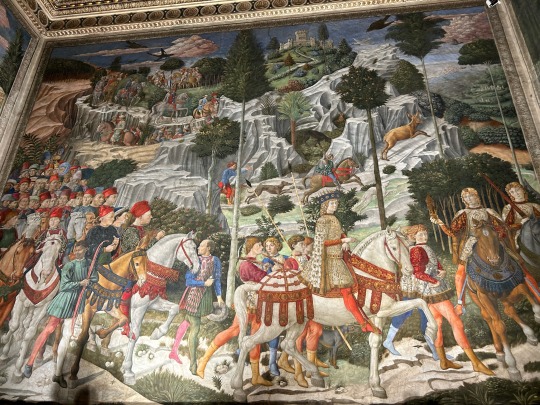
The 15th century Magi Chapel created for the Medici family. Palazzo Medici Riccardi, in Florence, Italy.
March 21, 2024
#chapel#architecture#travel#Florence#firenze#italy#italia#fresco#art history#original photography#iphonography#renaissance#museum#photographers on tumblr#photography#church architecture#Medici#wanderingjana
64 notes
·
View notes
Text

Medici Chapel Florence
8 notes
·
View notes
Text

‘Secret Room’ Decorated by Michelangelo to Open to the Public in Italy
He’s known for his colossal works, such as the statue of David, the floor-to-ceiling frescoes of the Sistine Chapel, and the dome of St. Peter’s which dominates the Rome skyline.
But it’s Michelangelo Buonarroti’s less bombastic work that’s on display to the public for the first time in the artist’s “secret room” in Florence.
The tiny space sits beneath the Medici Chapels in Florence, where Michelangelo sculpted intricate tombs for members of the Medici family behind the church of San Lorenzo in the Sagrestia Nuova, or New Sacristry.
In 1975, during works to create a new exit for the venue, a restorer carrying out cleaning experiments uncovered multiple drawings of human figures under two layers of plaster in a corridor underneath the sacristy which had been used to store coal.
The narrow space is 33 feet long, 10 wide and eight feet high.
The figures – sketched in charcoal and sanguine (rust-colored chalk or crayon), often one on top of the other, and of different sizes – were attributed to Michelangelo by Paolo Dal Poggetto, the former director of the Medici Chapels.

It is believed that the artist hid in the claustrophobic space for several weeks in 1530 when pope Clement VII – a member of the Medici family, who had recently returned to power in Florence, having been kicked out by a republican government for whom Michelangelo had worked – ordered his death. The death sentence was rescinded after two months, and Michelangelo returned to work in Florence, before moving to Rome four years later.
It’s believed the drawings are sketches for future works, including the legs of one of the statues in the New Sacristy.
“This place grants today’s visitors the unique experience of being able to come into direct contact not only with the creative process of the maestro, but also with the perception of the formation of his myth as a divine artist,” said Francesca de Luca, curator of the Museum of the Medici Chapels, in a statement. Paola D’Agostino, director of the Bargello Museums, which the chapels are part of, said the restoration has been “time-consuming, constant and painstaking work.”
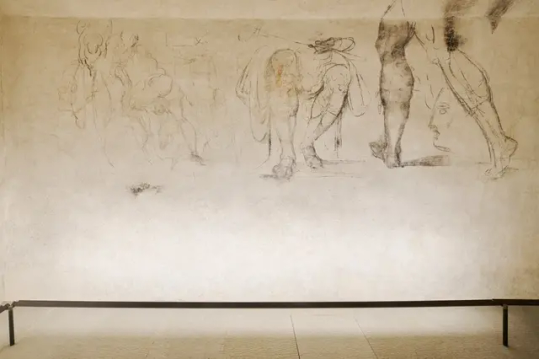
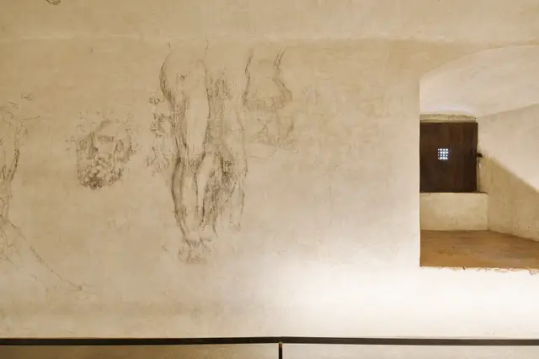
The space has never been open regularly to the public before, but will open for visits on November 15 to highly limited numbers in order to preserve the drawings. A maximum of 100 people will be able to visit per week, in groups of four, and 15-minute visits will take place every day except Tuesdays and Sundays.
By Julia Buckley.
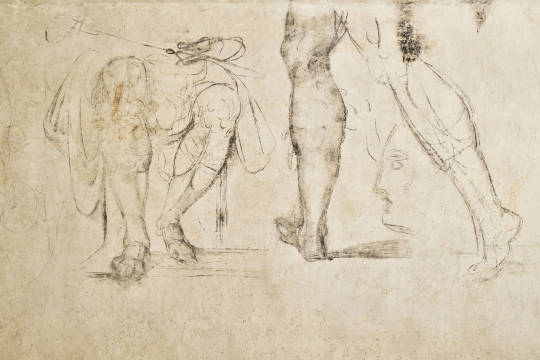

#Michelangelo#‘Secret Room’ Decorated by Michelangelo to Open to the Public in Italy#Medici Chapels in Florence#italian artist#charcoal drawing#sanguine drawing#art#artist#art work#art world#art news
34 notes
·
View notes
Text



The Secret Room. Accessible through the New Sacristy of the Medici Chapels in Florence houses sketches attributable to Michelangelo.
777 notes
·
View notes
Text




PALLAS AND THE CENTAUR /1482/ by SANDRO BOTTICELLI
It is a painting of the dramatic interaction between Pallas Athena, goddess of wisdom and war, with a centaur—a representation of chaos and barbarism. Here, Pallas Athena holds the centaur by his hair to indicate her dominance over his feral instincts.
The centaur carrying a bow may appear aggressive, representing primal urges and sensuality. Pallas is shown with a halberd, possibly pointing to her warrior side; she radiates wisdom and chastity. The dynamism of the two highlights the theme of rationality triumphing over base desires.
On Pallas' garment, a version of the three-ring insignia of the Medici house appears, hence indicating that the work was quite likely commissioned by Lorenzo di Pierfrancesco de' Medici, possibly as a wedding gift to his marriage in 1482. The composition is dated right after Botticelli's return from Rome, where he contributed to the Sistine Chapel.
There has always been a dispute over who the female figure is, often named as the goddess of wisdom, Pallas Athena, while other interpretations argue that she could also be Camilla, the virgin warrior from Virgil's Aeneid, hence the multifaceted nature of Botticelli's work. What do you think?
107 notes
·
View notes
Text

The Dawn, situated on the right of the sarcophagus of the tomb of Lorenzo de' Medici, Duke of Urbino, as decipted by the italian photographer Paolo Monti in 1975. Execution dated around 1524-1527. Sagrestia Nuova (New Sacristy), Medici Chapels, Basilica di San Lorenzo in Florence, Italy.
#sculpture#michelangelo#michelangelo buonarroti#16th century#renaissance art#italian art#dawn#medici#medici family#florence#dark academia
21 notes
·
View notes
Text
Ergo Proxy Opening: In search for the artwork's source
Ergo Proxy's Opening is a fascinating piece of artwork characterized by it's kaleidoscopic mix of scenery, images from the series and subtle references to pieces of art and literature. The whole design reminds me a bit of the style of Kyle Cooper in intro sequences like Se7en . Some are very clear while others are quite cryptic and frankly unreadable. This post will summarize a few of those references and their sources:
Holy Images
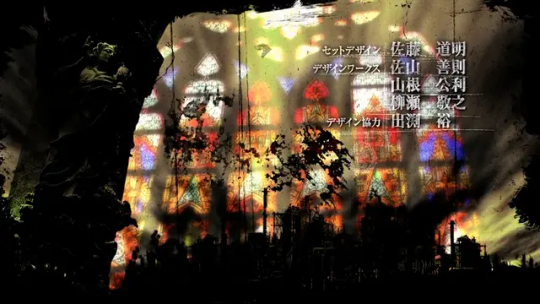
First we have the apparition of some glass panels and a statue in a column, and the image of some industrial complex. The statue have a chalice and appears to be a young man, and an eagle at his feet. Those are the attributes of Saint John the Younger. With that in mind, the search was easier... and after almost 14 hours of reading and searching, I found two of the three artworks.
Both the statue and the stained glass comes from the The Cathédrale Saints-Michel-et-Gudule at Brussels.
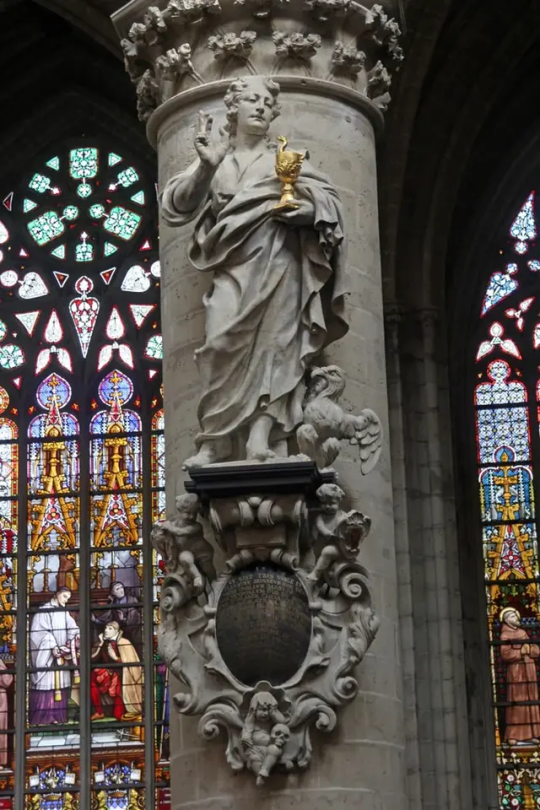
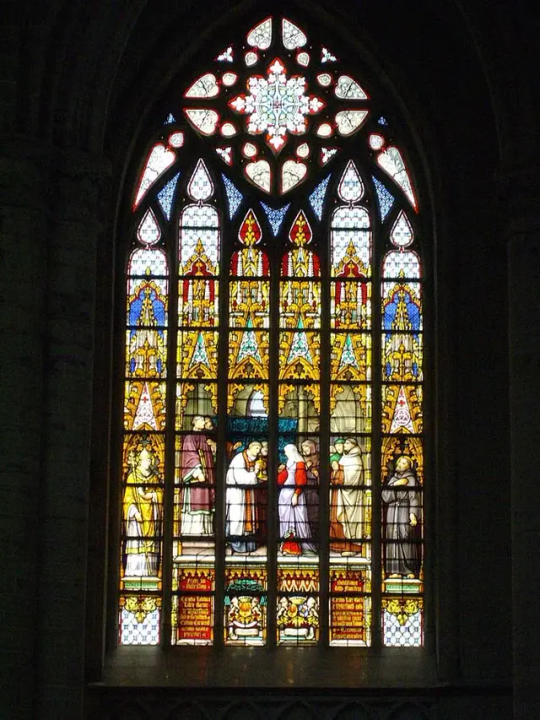
Stained Glass, probably made by Jean-Baptiste Capronnier (c. 1870):
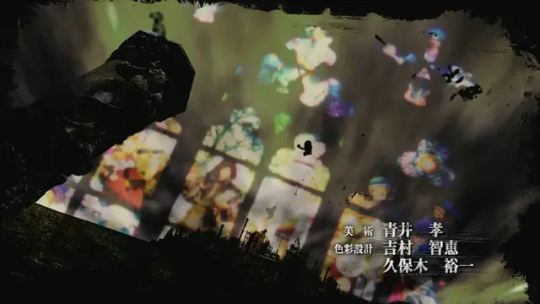
Another decorated window appears, this time with a more modern artwork. The decorated window was designed by Alfons Mucha, c. 1930, for the reconstruction work for St. Vitas Cathedral in Prague.
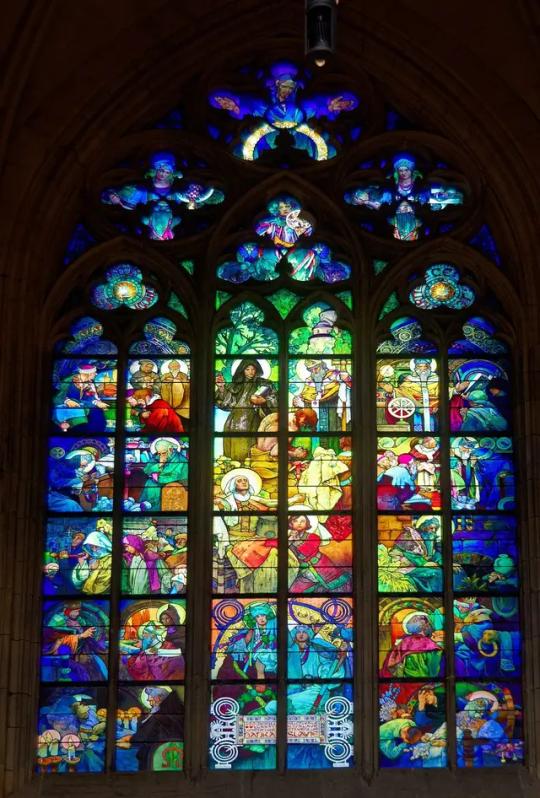
The Power of Seven and the Lapis Philosoficus
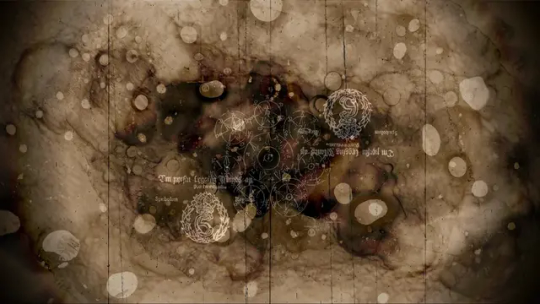
The occasional image of complex astrological or alchemical heptagrams flashes many times during the opening, being this one the most clear snap I could get. The text in the center of it reads "Ma Te Ri A Pri Ma *" that confirms the alchemical nature of the illustration.
After many attempts to find the source of the illustration i had to dive into my older alchemy notes. Suddenly I remember the works of a notorious alchemist obsessed with number seven, none other than Sir Isaac Newton. And Eureka!
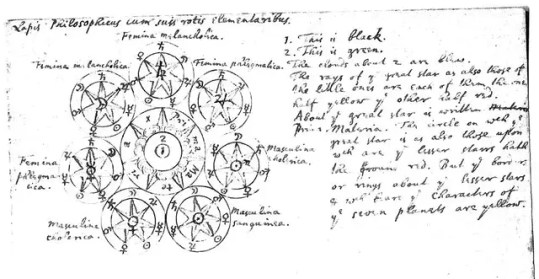
the image comes from a set of notes on the processes behind the achievement of the philosopher's stone, titled "Lapis Philosophicus cum suis rotis elementaribus" and dated to c. 1690
Landnámabók
Some of the decorations that appears on the opening comes directly from the icelandic text of settlers, a medieval Icelandic written work which describes in considerable detail the settlement (landnám) of Iceland by the Norse in the 9th and 10th centuries CE.
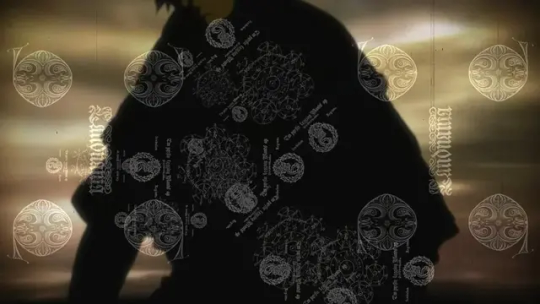

La Glorification de l'Art
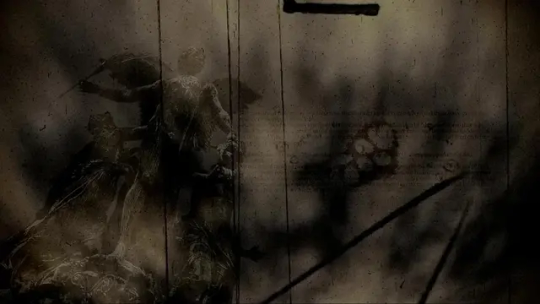
This one was relatively easy to find. It is a quite common allegorical representation.

The building housing the Royal Museum of Ancient Art in Brussels is a masterpiece designed by Alphonse Balat, the Court's favorite architect, the sculpture flanking the main entrance is the work of Paul de Vigne, and was made around 1885. La Glorification de l'Art depicts Art as a winged youth, accompanied by Glory and Fame. It also appears on the opening. Art, represented by a winged man, receives from the hand of Glory a palm and a crown; while the Fame, with trumpet and bumper, publishes her exploits.
Rhyme 247
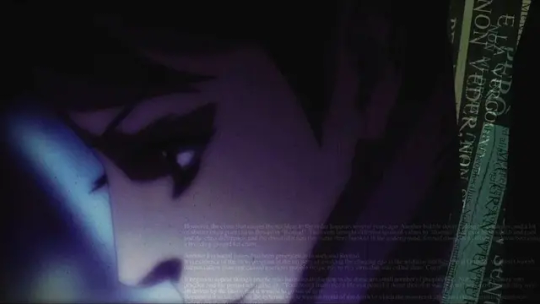
notice the words on the right side of the screenshot: "e vero", "Non Veder" "Gran Ventura"
Michelangelo Buonarroti was an exceptionally good artist, and a passionate poet too, even when he preferred to keep most of his literary production quite obscure. One of his works for the Sagrestía Nuova at the Medici Chapel in Florence was a representation of the Night, placed over the tomb of Giuliano di Lorenzo de' Medici, Duke of Nemours. Night was singularly praised by his contemporaries, especially Giovanni Strozzi, who dedicated an epigram on 1544:
La Notte che tu vedi in sì dolci attidormire, fu da un Angelo scolpitain questo sasso e, perché dorme, ha vita:destala, se nol credi, e parleratti.
Michelangelo responded in another epigram, today known as Rhyme 247:
Caro m'è 'l sonno, e più l'esser di sasso,mentre che 'l danno e la vergogna dura;non veder, non sentir m'è gran ventura; però non mi destar, deh, parla basso
This Rhyme appears on Ergo Proxy in another occasion:
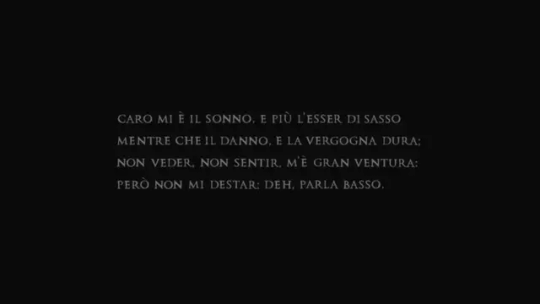
The poem as appears on the beginning of the first episode
NIGHT DAWN DAY DUSK
Donov Mayer's Collective Entourage are embodied by the four sculptures from the allegorical monument (Sagrestía Nuova) of Michellangelo. A pair of the statues were located over the sarcophagus of Giuliano de' Medici, (Day and the Night) and Lorenzo de' Medici (Dusk (or Twilight) and the Dawn) respectively. On the series, each have the name of one prominent occidental philosopher:
Lacan: as Night, Voiced by: Atsuko Tanaka (Japanese), Barbara Goodson (English)
Derrida: as Dawn, Voiced by: Yōko Sōmi (Japanese), Melodee Spevack (English)
Husserl: as Day, Voiced by: Hidekatsu Shibata (Japanese), Michael McConnohie(English)
Berkeley: as Dusk, Voiced by: Yuu Shimaka (Japanese), Doug Stone(English)

[Unknown]
Some artworks or pieces of literature used are still unknown (for me)
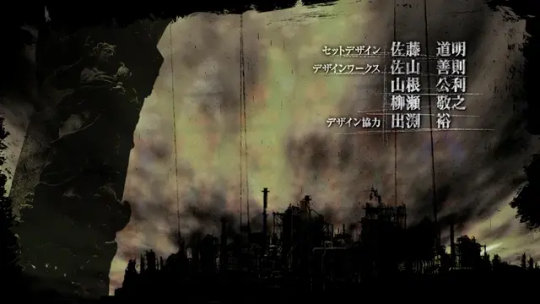
The industrial landscape
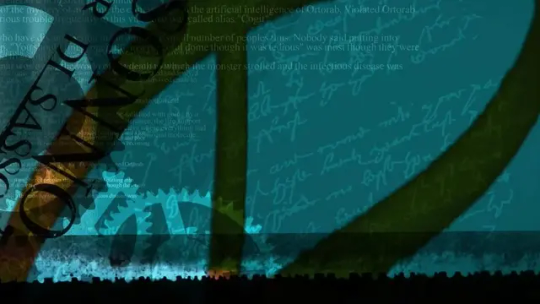
The cursive text

And this arabic/persian texts
Thank you so much for reading so far
31 notes
·
View notes
Text
Primo Emeritus: Florence.
This is the first of my posts where I locate each Papa in Italian cities based on the occult influences/history of each city. I hope you find it interesting and useful!
Primo | Secondo | Terzo

Primo Emeritus, The Old One, the embodiment of all that is sacred. A personality like his deserves to be located in an ancient city full of art, poetry, and history, shaped by the esoteric and alchemical obsessions of the Medici family, amidst the enduring shadow of centuries-old Satanic cults.
Let’s see why I have chosen Florence for Primo.
In this chapel of ritual…
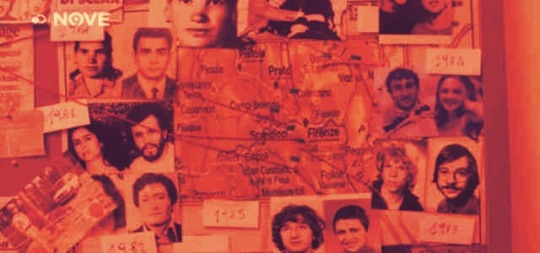
From the early 70s to the late 80s, a series of murders occurred in various regions of middle-north Italy, with the most infamous taking place in Tuscany, known as the case of the 'Monster of Florence' (Mostro di Firenze), which resulted in the deaths of 14 people - officially, but it is believed there were way more.
The theory is that these murders were part of a large network of Satanic rituals involving influential figures from Rome, Perugia, and Florence. This network is supposedly still active. The original cult allegedly responsible for initiating these rituals seems to be the 'Rosa rossa' (Red Rose) cult.
A fertile ground for writing Ritual...
2. The creator of Hell.

Florence is the birthplace of Dante Alighieri, the renowned author of the Divine Comedy and the creator of the now canonical structure of Hell.
Primo could have had many more things in common with Dante than we expect: indeed, it is said that Alighieri was part of an esoteric cult named ‘Fedeli d’Amore’ (Loyals to Love), probably affiliated with the Templars. From there, Dante is said to have drawn inspiration for his symbolic and esoteric tales, as well as his passion for numbers.
Keep an eye on Dante, as he will eventually come back in the next chapters.
3. The ghost behind the open window.
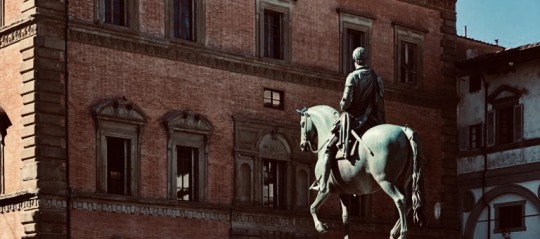
It’s not a Ghost story without an actual ghost.
In Piazza Santissima Annunziata, there is a building, Palazzo Grifoni, that holds a mysterious detail: a window that remains open at all times, whether day or night, summer or winter. Legend has it that a woman of the Grifone family bid farewell from that window to her lover, likely Ferdinando I, who departed for war. She waited for him by that same open window throughout her life, but he never returned, dying in battle. When she passed away, the window was finally closed. However, soon after, numerous mysterious events happened in the building, to the point the residents concluded that the building was haunted by the ghost of the woman, and they have kept the window open ever since not to upset her.
But that's not all: the Ferdinando I statue placed in the square, has his face turned to look right to that window… At the very end, he finally came back to her.
4. The Boboli alchemical garden.
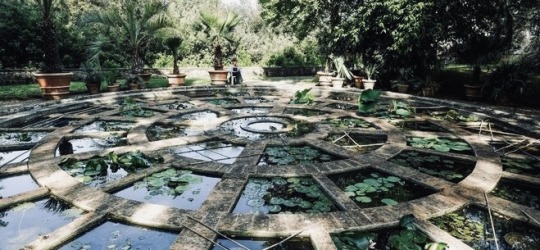
Boboli represents a very particular case of an alchemical garden conceived to be ‘accessible’ only to those who have a strong alchemical and esoteric knowledge. It is built as a symbolic route where you can contemplate the principles of magical and alchemical doctrine along the way. You’ll be welcomed by two fountains, placed one on top of the other: the Mose’s (it is an indoor fountain) and the Carciofo’s (artichoke). They are believed to represent the esoteric concept of “as above so below”, but the references to esoteric concepts are present along the whole garden.
Primo would have surely loved this place.
#ghost band#the band ghost#primo emeritus#papa emeritus i#papa primo#italian cities#ghost theories#Ghost band theories
94 notes
·
View notes
Text

this was the sign btw

the chapel of princes marks the first time on this trip i’ve walked into a space and said “holy fuck” out loud
like i cannot overstate just how unprepared i was to walk into this place
#do you see??#do you see just how unprepared i was for All That???#like#my guys#that sign is NOT proportional to the space it’s pointing to#you’re giving visitors dangerously low expectations of the space they are about to encounter#relative to what it actually is#anyway yeah if you’re in florence go to the medici chapels#and the san lorenzo basilica#i have been to many many churches across europe#they all start melding together at some point#this one is Memorable
7 notes
·
View notes
Note
what are your thoughts/feelings on the skylight being covered at the chapel?
I wish i could tell you but I havent been to the chapel in years. After the renovation, reports were good about the lighting but I saw it before that, so i can't say.
The lighting issue with Rothko is complex. It appears that through a lot of his life, he wanted the environments for his paintings darker than any gallery owner (and presumably some people) liked.
Others were on Rothko's side, feeling that the paintings have their own inner glow and that they get nothing from bright light. It was said that Goya painted highlights in the dark and I think Rothko was aware of this, but either way, he painted in natural light and wanted his work to be seen the same way it looked in the darkened studio environment (a darkened movie set is what Motherwell called it). He had seen the Medici chapel and was influenced by both its light and the feeling of being closed in there (quotes support these ideas).
I wont bore you with all my ideas about lighting here but I would say that everyone who presents Rothko's work, even on the level of making monograph scans of it, is faced with the problem of trying to be true to Rothko's wishes but also having the pictures "Play" effectively. In books it's the way they look printed on the page and in museums it's a complex issue of having it be effective for a large group of people. I have heard people complain the chapel was too dark and all reports after the renovation that i heard were positive, but as always, someone will be displeased with more light (against Rothko's wishes) or less light (I can't see anything!).
I always find this quote interesting, from someone who knew Rothko
"He used to come down to the Phillips and tell them to reduce the lighting more and more. He thought that the tones set-I don't know, I assume he thought the tones were set by the atmosphere. If you make it too bright, it's punchy. It's all right for a certain kind of painting. His painting he wanted low lit especially in a room. I mean he is still thinking of the Medici Chapel. What is that room? They say the Medici Library but it's not the library. There's nothing in the room...He talked about the effect of the walls. That was the big thing. He was probably the first artist who really noticed it to that degree."
- Jacob kainen
And a little amusing story on the same subject
Philip Guston went with Rothko to see one of Rothko’s shows at Janis,They strolled into the gallery and Mark, without a word, switched off half the lights. When Janis emerged from his office, the three of them chatted a bit and, in a pause in the conversation, Janis slid off and turned all the lights back on. Rothko didn’t say anything. They finished their visit; Janis went back to work, Guston and Rothko waited for the elevator, and just before they entered it, Rothko turned half the lights back off again. ‘I’m positive,’ Guston says, ‘that Mark sneaked up there every day and turned the lights down – without ever complaining or explaining."
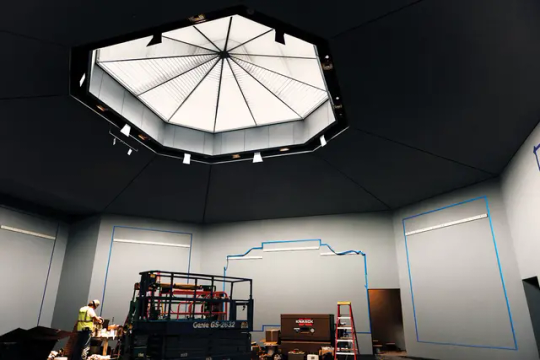
Skylight restoration Photograph by Arturo Olmos
#mark rothko#markrothko#rothko#daily rothko#dailyrothko#abstract expressionism#modern art#abstraction#colorfield#ab ex#colorfield painting#mid century#questions#lighting
76 notes
·
View notes
Text

The Secret Room. Accessible through the New Sacristy of the Medici Chapels in Florence houses sketches attributable to Michelangelo.
via @eccellenze-italiane
90 notes
·
View notes
Text
CENTER OF THE WORLD [fantasy short story]
Personified immortal Stars have lived secretly on Earth throughout history. This piece takes place in 16th century Florence, right at the brink of the Copernican Revolution. Sol, the beloved sun king, is presented with an endless battle and an impossible choice. The Stars' world was created by myself and @heirmyst. Previous post: [THE THREE BIRDS] [ORION'S FINEST] [GATHERER OF GRAIN] Word count: 4,453
The air grew colder by the moment as the sun set. Sol, soaring through the overcast sky, had to stamp down the instinct to burn brighter. Instantly, as daylight faded, the flight grew tedious, but not because of the cold. Sol hastened his wingbeats to reach his destination sooner; anything to stop having to dim his flames.
Finally, he descended into the old Medici palace’s chapel, only letting the protective cloaking field drop once the walls securely surrounded him.
Beaming, he spread his arms, ready to receive his fellow Stars. “I am here!”
His flight-blurred vision cleared, only to reveal… nothing. The cavernous space of the chapel only echoed back his own words.
And the sound of a loose page turning.
Sol walked toward the steady, calming light that radiated from an opposite corner. Cann sat alone, hunched against a wall in a way that couldn’t have possibly been comfortable for their wings and engrossed in a bound tome.
“I said,” Sol repeated, with greater enunciation, now that he spoke only to one fellow Star. “I have arrived!”
“I can see that, my king,” Cann said mildly, without looking up from their book. “I heard you the first time, and knew you were coming well before then.”
He stiffened. “Did I fail to disguise my light enough?”
“Oh no, it was more than enough for the mortals,” Cann said with a laugh, their eyes glowing with lavender flame to make the point. “But there’s no hiding from me.”
Sol sighed. He folded his wings back down and leaned against the pillar facing the other Star. “Where are the others, Canopus?”
Cann shushed him, impatient. “I’m almost done!”
“Is it truly that riveting?” Sol asked flatly. “You read too much.”
Cann didn’t give him the satisfaction of responding to the remark, or even acknowledging that they heard it. They simply flipped through the last fifty pages in the span of a few minutes and put it aside. Finally meeting Sol’s eyes with the utmost seriousness, they said, “No such thing as reading too much.”
“There is for you!” Sol argued. “You can know anything without lifting a finger. What use would you have for mortal books?” Absently, he picked it up, ready to cast it aside before the words on the cover caught his eye. It read, On the Revolutions of the Heavenly Spheres.
“For one,” Cann said, smiling, “It’s an invaluable resource on keeping up with the mortals. I know what I know, but it’s useful to keep a finger on the pulse of what they know.”
Sol found himself leaning forward. “And… what do they know?”
“It appears that one of them has taken a shot in the dark.” They held a palm out and produced a small pocket illusion; two spinning orbs, one large and golden, the other small and blue. “He has come to the revelation that the Earth revolves around the sun, not the other way around.”
Before Sol knew it, he was perusing the book. The words blended together, but the diagrams scattered throughout held his attention. He vaguely remembered secret keeper al-Tusi and the rest of the observatory students in Iran shoving quaint pictures in his face, some near identical to the ones in this tome. Somehow, their legacy had carried itself to a mind several lands away.
“How did the astronomers of the caliphates never come to this?” Sol asked.
“A misguided question,” Cann said, ending the illusory demonstration. “You cannot judge them by the standards we have because of what we know, especially because they were brilliant on their own terms. I believe you would be better served asking why this man did make this departure.”
But Sol’s mind did not have the space to ponder Cann’s philosophical proposals. Basking in the satisfaction of finally having his centrality out in the open, no matter how fringe this mortal’s reach might have been, was too momentous to be disrupted by anything else.
He caught Cann’s wry, knowing stare and tossed the book back to them. “As if I needed the humans to tell me what we’ve always known,” he said, trying his best to wipe the smile off his face. “Well, leaving that… why have I returned to an empty palace tonight?”
Cann stood, smoothly snapping to attention. “Hauntings have decided, very unwisely, to camp outside the city walls. A show of force, I gather. The others have flown out to neutralize the flock.”
“All of them?” Sol asked, surprised. “Even Sirius?”
“Especially Sirius,” Cann corrected. “Vega insisted upon having him. You know how they get when the other side of fate’s scales tips even an inch downward.”
Sol nodded proudly. “North Star V never misses,” he said. “Still. How have they not asked you to join?”
“We aren’t that desperate just yet,” Cann said lightly. “Some blasts need to be held close to the chest.”
On cue, colorful flames lit up the chapel’s entrance. As Sol hastened to adjust his crown and take his place on the steps, Cann strode forth to meet the Stars. The group, freshly out of battle, frantically scrambled to make their various reports known. V shoved their way to the front of the group, buzzing with urgent blue lightning, but at the sight of Cann, considerably relaxed.
Placing a sympathetic hand on Cann’s shoulder, V said, “I wish you only the absolute best of luck.”
Cann only blinked at them, confused. “For what?”
“My king!” Alpha Pavonis’ cry rose above the other Stars’ chattering, catching Sol’s ear. “May I have a word?”
Before Sol could open his mouth, Cyon sprang to hold Alpha Pavonis back. “Oh, don’t you dare!” she yelled. “You do not get to skip your way directly to the king, Pav. This is unacceptable!”
The two continued to struggle against each other, the arguing punctuated by warning blasts. V turned to Cann. “Enjoy dealing with that,” they said. “I’m going to do away with the debris from the latest flock.”
“Wait, the latest flock? Vega!” Cann protested, grabbing for their hand, but V was too fast, making a quick exit in a flash of lightning. Cann gestured wildly in Sol’s direction.
“Stars, silence!” Sol commanded. Instantly, the room quietened. Cyon had managed to pin Pav to the marble floor, before she was pulled to her feet by Sirius, who whispered calming words to her. Satisfied, Sol made his way down the steps. “Bring forth your reports one at a time.”
“Affirmative,” Cyon said, dropping Sirius’ gloved hand and walking toward Sol. “You see, the matter at hand is that Alpha Pav—”
Sol held up a hand to stop her. “Now, if you will begin by recounting a fellow Star’s argument, I would rather hear it from the source themself.” He glanced at Pav, who was getting back on their feet. “The sky is yours, Alpha Pavonis.”
“Ah… thank you?” Pav stammered out. Quickly regaining composure, They stood tall and trailed their peacock hued robes behind them. “My king, as I’m certain you have gathered from the North Star’s words, we have not one Haunting flock on our hands, but a ready, almost endless queue. Every time we neutralized one at the walls, another rose to take its place. We slowed it down, and even then, Vega might meet another while they’re gone.”
“Are you implying we are low on firepower?” Sol asked. “Has Sirius’ deployment not eased any such concerns?”
“Yes, but—”
“Yes, and,” Cyon corrected sharply. “Show some respect.” Beside her, Sol could have sworn he saw Sirius grinning under the cover of his mask.
Pav glared at the two, but went on undeterred. “Why continue the grueling task of taking them out one by one, when we have what it takes to frighten them off for good?”
They paused, as if their implication was obvious. Sol glanced back at Cann, who only shrugged. They were as confused as he was.
“Explain yourself,” Sol said.
“Why… we have you, my king.” Pav said. “If you send a warning using the most magnificent celestial body in the sky, they’d be forced to take heed, yes?”
“Sol,” Cann began, warningly. “This proposal is too ambitious for its own good.”
“You’ve spoken above your station more than enough, Pav!” Cyon piped up.
“Sirius,” Sol said. “Please restrain your wife.”
“Of course, my king!” Sirius’ constant flames brightened as he reached for Cyon’s arm. “Regardless, for the benefit of the court, Pav’s suggestion would be a severe violation of our arrangements with the Medici. Any unforeseen celestial events here will be seen by the entire population of Florence, and we could be—”
“Cyon,” Sol cut in, already tired. “Please silence your wife.”
“Heard loud and clear, my king.” But she was still glaring daggers at Pav, who was looking back at her with presumptuous, smug satisfaction. Sirius was barely managing to hold her back from attacking again.
Sol decided he had no time for this. “Cann!”
Cann stepped forward, wings and arms spread to usher everyone out of the room. “Say no more. Because no one here is my wife.”
“Your loss,” Sirius said, and collective airy laughter echoed around the chapel.
Sol let himself breathe, relieved by the tension dissolving. Sirius laced his fingers through Cyon’s and led her out of the room. The other Stars swiftly followed them, their conversations now far more lighthearted. Only Pav lingered behind, slow to budge. Sol took a tentative step toward them.
“That means you too, Alpha Pavonis!” Cann ordered, cutting any action short now that Pav had no choice but to listen. “Move!”
“All of your concerns have been heard!” Sol promised the exiting Stars. “Allow me until the next sunrise. We will proceed only with what is best for you!”
“You heard him, next sunrise!” Cann repeated for emphasis. “For skies’ sake, don’t let me catch any of you out of your quarters before then. I will know!”
Once everyone else left the hearing range, Sol sank into the altar seat, gripping the crown on his head tightly between his hands. He only had some hours to figure this out, and failures awaited him in every direction; which of them would be less shameful to bear?
Cann cleared their throat. “Is everything alright?” they asked, the calculated performance of the king’s advisor flawlessly shifting to the softness of a friend.
Sol tried to smile back, but it felt hollow. It always did when he was with Cann. And yet, even as he knew there was no use, he found himself saying, “Yes. Hauntings and mortals have never stopped us before. This is an inconsequential matter.”
Cann raised an eyebrow. They both knew full well nothing involving the sun could ever be inconsequential to Stardom.
“I… must think this over,” Sol said. “Alone.”
“If you say so,” Cann said easily, no trace of accusation in their voice. Sol watched them gratefully as they marched out of the chapel without another word. He loved it when they played along this way; it almost lulled him into the false comfort of thinking something could get past their sharp, all-seeing eyes.
With no one except his own light for company, Sol mulled over the decision, thinking about every angle hard enough for flames to rise his fingers, carelessly scorching the wooden chair. Skies above, fragile human furniture was a pain.
He stood, hating how he couldn’t even claim ownership to the walls around him. Resentfully, he let his gaze drift over the painted frescos surrounding him, scenes of mortal processions and hunts. He’d find the pomp endearing if it wasn’t so offensive right then. These were the beings he and his people had to hide from? When would they wake up to the truth that the Stars outshone them in every way?
Except… His stroll through the hall finally came to Cann’s forgotten pile of books. On top rested the one that spoke of the sun’s centrality.
Some already had woken up, hadn’t they?
Coming to a decision, Sol walked out of the chapel, steps as delicate as air. He could not sit idly. The lurkers thought they were out of reach, with their clever queue rotation, but Pav was right; they’d run at the first sight of Sol. He weaved through the palace corridors and bypassed the nearest window in a flash of light.
Veiling his fire as well as he could given the stark contrast against night, he fluttered carefully into the air.
Lightning struck the palace roof; V had arrived, landing unsteadily against the rough masonry. Sol moved instinctively, backing himself against the nearest wall to hide. Did they have to return just as he was leaving?
“Vega?” Sirius’ voice floated in, his footsteps rushing to join them. “Did you manage the mess? The wall remains untouched, yes?”
Catching their breath, V laughed. “Managed,” they repeated bitterly, with a break in their voice that made Sol worry. Were they hurt? “Guess who came to taunt me when I went to clean up?”
Sirius sighed. “Another encampment?”
“I don’t know where they keep coming from! It’s as if they can’t leave the walls unoccupied for even a wingbeat, the stubborn fucks.”
“We outdo their stubborness, then,” Sirius said, his voice far less confident than the words. Sol’s heart sank; his strongest soldiers were battling themselves to exhaustion, all for the feeble, sheltered minds of this city’s mortals. “We need a plan of action. Between Pav and Cyon, whom do you think—”
“Stop,” V cut in, irritated. “Your nonsense infighting can wait until sunrise. We aren’t even supposed to be out of our quarters. In, now!”
Their footsteps and further conversation faded. If Sol’s resolve ever faltered during his exit, this hardened it beyond return. The Hauntings’ intimidation tactic could not be allowed to stand anymore.
Letting the anger fuel him forward, Sol set a course straight for Florence’s walls.
The closer he flew to the edges of the city, the murkier the sky became. Too soon, every precious star adorning the cloak of night disappeared, and he had nothing to glance up at for strength.
Enough, he thought to himself, steeling his nerves. It is I who must give them strength now.
The weight of the blotted sky burdening his every wingbeat, Sol arrived quietly to the scene of the northern gate. Below, three Hauntings lay in wait on burned grass. Sol didn’t know it was possible to make nighttime even darker; these sentient black holes masquerading as earthly creatures always proved him wrong. He set his feet down on the wall’s brick facade, stepped off the end, and let his light burst forth.
“Leave these walls!” he yelled.
Immediately, high whistles rang out as the Hauntings rushed into formation. One of the quicker front soldiers, clam-like in shape, launched a black-stained pearl the size of a boulder.
Sol braced himself, burning hands ready to intercept it… but the hit never came.
Just as the cannonball corralled to knock into Sol, he was on the ground, untouched, the pearl dropping unceremoniously a few feet away from him. The Hauntings froze, confused, inadvertently allowing him a moment to regain his bearings.
Enough to see that the stained pearl now glowed lavender.
Keeping a flame at the ready to ward off the Hauntings, Sol looked up at the wall behind him and yelled, “Cann!”
On command, a head emerged at the top. Cann peeked down. “My king,” they greeted, not bothering to sound the slightest bit chastened.
“What are you doing here?” Sol asked. The clam Haunting unwisely decided to rush him. Sol’s flame cut him down in an instant. “Out of your quarters, at this hour?”
“I could be asking you the same thing!” Cann swooped down at the last word, tackling both remaining Hauntings at once. “Did you think you could hide from me?” Even as they punctuated each word with a calculated strike, Sol got the feeling the anger in their voice was not for the creatures. “Or did you want me to graciously look away, as you crept off to this endless fight?”
Successfully, Cann brought a frail reptilian Haunting flat onto the ground. The companion, an armored, plump one, continued to trade blows with them.
Sol rushed to their side, knocking the Haunting off course with one fatal punch to the head. He shook off the flame, triumphant. “That will teach you.”
“Sol…” Cann whispered warningly.
“Don’t… think this is over,” a new voice said, wet and halting. The clam Haunting was still on the ground, a hole burned into his weak internal flesh. That did nothing to compromise the smugness of his declaration. “You can’t take us all.”
Sol’s fist burned, but Cann touched his arm, silently telling him to save it.
“Wonderful,” Cann muttered. “Another entry in this queue will be here any moment.”
“Oh, don’t act as if this was wrong of me!” Sol shot back. “Would you rather I sat comfortably in the palace while this went on? Pav said—”
“Pav is a showboating windbag,” they said drily. “Why are we listening to them?”
“It is our only option,” he said. “These Hauntings need to be cleared out, and if the cost is some inconvenience to the mortals—”
“The cost is you, Sol!” Cann’s voice rose to a volume Sol had never heard before. Softer, they went on, “You don’t have anything to prove to mortals, or Hauntings… anyone.” Desperate, they reached for his hand. “The sun’s face is all the more precious because it’s our secret. Why would you throw that away?”
“Cann…” Sol’s words died in his throat. He never considered what he’d be giving away. Even if he frightened the Hauntings, what would become of the Stars if they were unveiled to the mortals thanks to his carelessness?
He was the center of the world. For the first time, he hated that truth.
A dark mist closed in, followed by quick feet hitting the ground. More Hauntings were coming. Sol’s heart raced. What was he going to do, surrender to the enemy, or betray the secret? He racked his brain, at an impossible loss.
Until he locked eyes with the Star beside him, and everything fell into place.
“Do you know what I’m thinking?” he asked.
Cann’s smile shone even brighter than their burning eyes. “I know everything.”
Without having to say anything else, the two of them parted, Cann holding their ground against the incoming flock as Sol took to the sky. Trusting Cann to keep the Hauntings busy, Sol watched the horizon, waiting for the perfect moment.
The smallest glimmer of the coming dawn’s fire was all he needed. “Now!” he yelled.
He glanced down, only to realize with horror that he’d distracted Cann at a crucial juncture. A well-toned amphibian Haunting seized the opportunity, wrestling Cann to their knees as the force of the flock descended on them. Sol hovered uselessly on the spot, paralyzed by the sight, his eyes darting between the battle below and the sunrise.
He could not fail. Not like this.
Then, the sky cleared.
A concentrated beam of lavender light had cut through an opening between the Haunting’s limbs and shot into the sky like a beacon. It reached its zenith and dispersed, sending a dome of thin, shimmering illusion descending onto the battleground.
A curtain. They were safe from outside eyes.
Cann brushed their horrified assailants off and struggled to their feet. They looked up at Sol. “Do it!”
The sun was now painting the sky red. Sol caught hold of its fire and, working like a strategically placed glass, focused its wrath on the toad Haunting who had led the latest charge. The skin ignited. High-pitched screams pierced the air, from the toad and the rest of the flock alike. Sol glared, unblinking, making his silent threat clear. The sounds faded mercifully fast into the distance as the Hauntings made their escape, away from the walls of Florence. Cann joined Sol in the air, wasting no time in putting distance between themselves and the retreating flock.
“Are there more coming?” Sol asked.
Cann briefly scrunched their face in concentration, then relaxed. “No,” they said, satisfied. “All of them are retreating.”
The weight of the sky seemed to be lifted off Sol’s shoulders as the two Stars made their way to the wall. They’d done the impossible, put an end to the endless fight.
Sol landed on a higher palisade of the wall, and beamed at Cann when they followed suit. “Let it never be said you don’t deliver, Canopus.”
“Never be said?” Cann asked. “Even by you?”
The joke lacked their usual flair. Still, Sol didn’t let that chip away at the euphoria of a hard-won victory. “You’ll catch me saying no such thing.” He clapped Cann on the shoulder. “Truthfully, I don’t know how you—”
The force of the playful hit made Cann stumble a step forward. They caught themself in time… but that slight gesture shouldn’t have fazed one of his strongest Stars at all. Sol noticed too late that they were clutching their robes pointedly to the side with both hands, as if to cover something.
He stood at attention, now alarmed. “Cann…?”
“It’s alright!” they managed through shallow breaths, smiling so genuinely that for a moment, Sol fully believed the words. “We won.”
They collapsed at his feet, and the protective dome above faded to nothing.
“No!” Sol sank to his knees beside them. He turned them over to reveal viscous black staining their robes. The lead Haunting had poisoned them in the scuffle; it had corroded deep enough to graze their skin. He brought a flaming palm to the sizzling wound. Even in the warmth of his arms, Cann was shivering. Their eyes did not open. “Fight it,” he begged.
He couldn’t win this way. This cost was too much to bear.
“Over there!” a voice called from the sky. V led Cyon and Pav to the wall, their excitement and relief palpable through the wind. As they flew closer though, V’s smile instantly fell. The three Stars landed on the top of the wall.
“Cann, you idiot…” V cursed under their breath. “What happened?”
“I used the sun to drive them out,” Sol said, not taking his eyes off Cann.
“Oh?” Pav asked, with barely restrained glee.
“But I made certain no one would see it.”
“Naturally,” Cyon said, pointedly glaring at Pav. “Because how thoughtless would the alternative have been, right?”
Sol’s face burned with embarrassment. As if he needed to be told now.
“Both of you need to shut it!” V took it upon themself to say. “Make yourselves useful and get them to Sirius, before the Haunting venom spreads too far.”
The Stars gently pried Cann away from Sol’s grasp. Still continuing their debate wordlessly with their eyes, Cyon and Pav flew off, supporting Cann’s weight between them. Sol watched after them, only snapping out of his thoughts when V spoke.
“The old ‘illusion of safety’ curtain trick, yes?” V asked, impressed. “Why didn’t I think of that?”
“Would it have ended better if you had?”
“Don’t say that, it ended well enough! If the Hauntings have even half a brain between them, you scared them off for good!” V argued. “And Cann will be fine. It’s Cann, for skies’ sake.”
“They better be.”
V sighed. “I’m going to clean up this mess.” They gestured vaguely to the fires and black puddles. “Go back to the palace. See how they’re holding up.”
Sol was off to the palace practically before they finished speaking. To mask his flight, he followed a sunbeam; it was, thankfully, much easier to disguise himself in the daytime.
He practically kicked down the ornate door to the chapel.
“Come now!” Sirius was saying. His gloves were off, and his constant flames were uninhibited as he tried to hold a struggling Cann down to the altar. He was succeeding, but only barely; Cann almost matched his strength. “Would it end to you hold still for—”
Sol cleared his throat, and the two of them snapped to attention. “Everything is in order, I assume?” he said.
“Yes, my king!” Sirius said. “But I need to attend to them at least until noon. It’s simply Haunting wound protocol.”
Cann scoffed. “Spare me the protocol, Sirius. The poison barely even took.”
Sirius crossed his arms. “And whose fire is to be credited for that?”
“If I may,” Sol said, amused. “Sirius, allow me a word with Cann. Protocol will be followed unfettered after this.”
Sirius bowed his head and stood. “As you wish.” Leaning closer to Sol, he whispered, “Make sure to dedicate at least some of your time to telling them to stay put.” He vacated the chapel, leaving Sol and Cann alone and shutting the door securely behind him.
“Ironic,” Cann remarked. “That he believes you can tell me anything about staying put.”
Sol didn’t return the humor. “Do not deflect from the matter at hand.”
“Oh, are we doing this? Fine,” Cann said with a roll of their eyes, like they were being asked to perform a menial chore. “Yes, I’m perfectly intact and will be back to fighting shape by next sunrise. No, the poison is not your fault, and if you even try to insist otherwise, you fundamentally misunderstand why I followed you. And don’t worry, as far as the other Stars will know, your unbelievably rash stunt did not happen, and the curtain was our brilliant plan all along.” They took a breath. “Did I miss anything?”
Sol stammered a few half hearted responses, having to give up in the end to avoid appearing even more foolish. He took a seat beside Cann. “I wish you would stop taking all the gravitas out of my heartstopping speeches,” he said finally, smiling despite himself.
“You are very predictable.”
Companionable silence overtook them. Sol draped a wing around Cann’s side in case the biting cold of the poison hadn't subsided. Cann did not pull away.
“It bothers you, doesn't it?” they asked softly. “That I can read your intentions like an open book, but you can never have that certainty about mine?”
“It would help,” Sol admitted. “If I knew you intended to take every hit at the wall…”
“You couldn't have stopped me,” Cann said. “No more than I could have stopped you from sneaking out.”
“Well, thank the skies for that, I suppose.” He watched the murals around him, feeling pride, more powerful than the envy or indifference the pieces had inspired before. Despite it all, the truth remained that he’d survived more in the past hours than the commemorated mortals would face in a lifetime. He could make peace with that, if nothing else. “Stardom lives to see another day.”
#writing#fantasy writing#short story#original character#oc#stars collapse#en writes#historical fantasy#last of this miniseries finally! i finished it#more importantly i have released cann into the world#cann broke containment and forced their way into this honestly but still#also sol is here. being himself.#anyway please talk to me about how much copernicus owed to islamic astronomy thank you
35 notes
·
View notes
Text
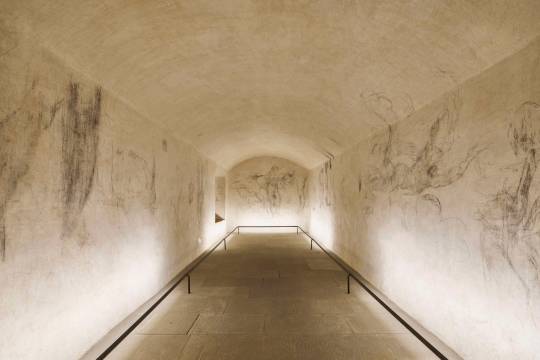


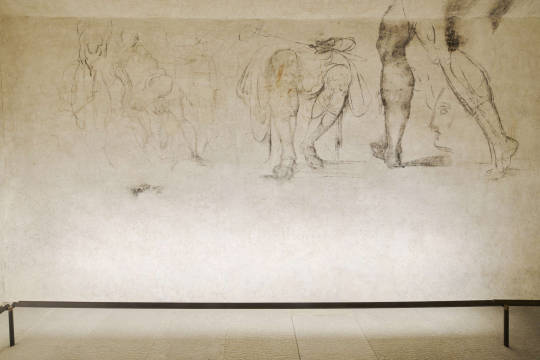

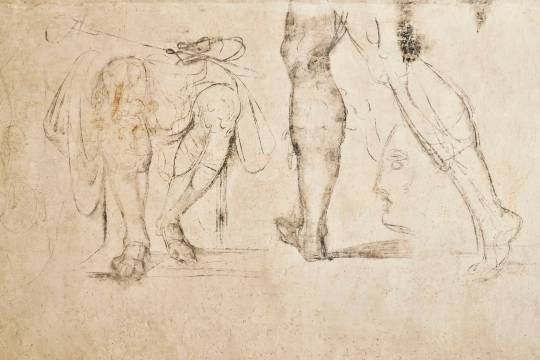
Secret room, Medici Chapels, Basilica of San Lorenzo, Florence
In 1530, Michelangelo went into hiding after receiving a death sentence from Pope Clement VII. The iconic Renaissance artist had been caught in the political strife of his patrons, the Medici family, who had just returned to Florence after being overthrown by a populist revolt in 1527.
During their exile, Michelangelo worked with the short-lived republican government to help secure the city’s defense walls and so became an enemy of his powerful supporters.
It is believed he spent two months stowed away in a tiny vault stretching just 32 feet long and 6.5 feet wide, with 8-foot ceilings at their highest points and a single window to the street, before the pope rescinded the sentence.
The claustrophobic room also became a canvas for the artist, who’s thought to have sketched dozens of drawings on the walls. Using carbonized wood and red chalk, the artist rendered several figurative works, including the head of the ancient Laocoön sculpture and iterations of his own masterpieces, including his Leda and the Swan painting and iterations of his David statue.
The drawings were hidden until 1975 when the then-director of the Medici Chapels, Paolo Dal Poggetto, was trying to find a new space for the museum exit. A trapdoor under a cabinet led to the room, which was filthy from housing slack coal for two decades. When the walls were finally stripped of two layers of plaster, the museum discovered the artworks.
All images courtesy of the Bargello Museums, Florence
#art#history#design#style#drawings#michelangelo#medici#florence#italy#secret room#bargello museums#renaissance#charcoal#chalk
77 notes
·
View notes

